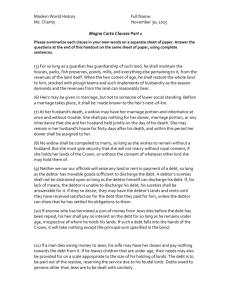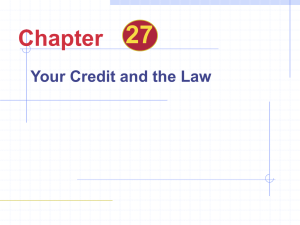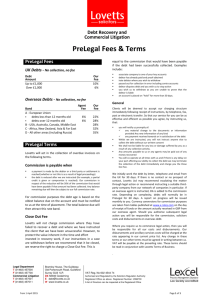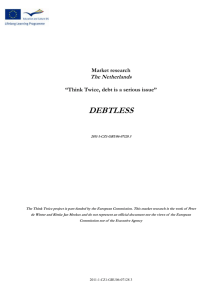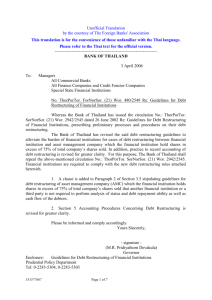Contracting for Debt Restructuring
advertisement
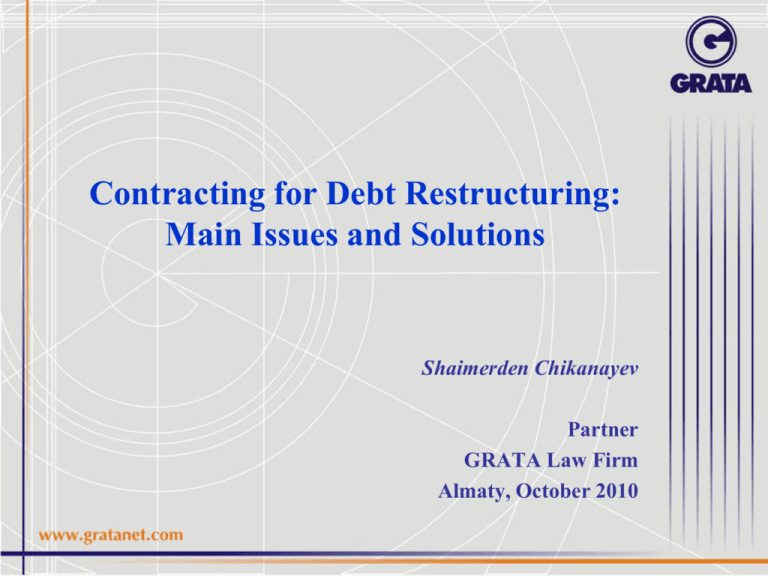
Contracting for Debt Restructuring:
Main Issues and Solutions
Shaimerden Chikanayev
Partner
GRATA Law Firm
Almaty, October 2010
Who's in Fault and What Shall We Do?
• The main issue in Kazakhstan are outstanding
debts in the corporate sector.
• As of 28 October 2010, 29 issuers are in default
on bonded debts (including Astana-Finance JSC
and Kazakhstan Kagazy JSC).
• Debts 'erode' the profitability of existing
business and banks are not able to find reliable
borrowers.
• Until the business debt situation is not settled, no
progress in Kazakhstani economy can be
expected.
2
What Banks Think
• Bankruptcy is not an option (5 priorities with
secured creditors second in the line)
• Debts recovery and enforcement of the pledge
through the court is a time and funds consuming
option (3% court duty) and bank loses a client.
• Extra-judicial enforcement of the pledge - the
pledge value may not cover the entire debt, and
the borrower can oppose the sale of pledge
3
Features of Bank Loan Restructuring
• Legal Instruments:
(i) credit term postponement and provision of a grace
period ('repayment holiday');
(ii) changes to the repayment schedule without changing
the deadline;
(iii) partial debt forgiveness providing advanced
repayment of credit ('discounted repayment');
(iv) reduction in the interest rate;
(v) refinancing (replacement of the old credit with one or
more new loans);
(vi) discounted debt buy back.
• The way of restructuring such as exchange of the debt
for debtor's shares is not available for Kazakh Banks.
4
Option 1
Multilateral Offset
• 'Perfect alternate': counter-claims of creditor and
debtor that are due (see Article 370 of the Civil
Code).
• Multilateral Offset: creditor owed debt to a third
party, which is in debt to the debtor.
• The transaction can be finalised in a trilateral
agreement, but it would be rather done in stages
(debts assignment - offset - offset).
5
Option 2
Break Fee and Novation (a)
• If there are no ways for offset, break fee and
novation can be applied (Articles 369 and 372 of
the Civil Code).
• Condition is the presence of the debtor's
property, which he agrees to provide in payment
of the debt and is of interest to the bank.
• Novation is safer for the creditors since courts
may interpret the break fee agreement not as an
undertaking but as the debtor's right to perform
obligation in a different way.
6
Option 2
Break Fee and Novation (b)
• If a debtor, having signed the agreement, still
fails to provide the creditor with the property
promised, the latter will not be able to reclaim it
through the courts, since the break free
agreement shall only take effect from the date of
actual execution, i.e. after the transfer of the
property.
• Practice: creditor can get the pledged property as
a break free without tender.
7
Option 3
Creditor's Debt Buying by the Debtor's Parent
Company andMutual Debt Forgiveness
• As a general rule, claims are sold with a
discount, but the debt amount is not changed
• In this case, the income arises for the debtor,
since the debt repayment is its obligation under a
credit agreement.
8
Peculiarities of the
Bond Debt Restructuring
• Bonds are usually not secured;
• Large number of separate creditors;
• Difficulty with isolation of the aggressive and
'difficult' creditors ('Standstill Agreement'/a
successful restructuring needs the consent from
all creditors).
9
Option 1
Changes to the Bonds Issue Terms
•
•
The issuer's proposal usually contains the following
elements:
(а) repayment term extension;
(b) repayment by instalments;
(c) coupon increase;
(d) stricter covenants;
(e) additional guarantees/pledges.
This option requires notarisation of consents from all
creditors and changing to the prospectus of bond issue.
10
Options 2 and 3
Discounted Debt Buy Back or
Replacement with Another Debt
• The way to restructure through the redemption of
bonds is applied when the issuer has spare cash,
and if a significant discount is possible to obtain.
• Replacing the default bonds with new bonds can
be used as a way of restructuring.
• Kazakhstani legislation prohibits the payment of
bonds with other securities (Article 23.2 of the
Securities Market Law).
11
Option 4: Debt for Equity Swap
• This option of restructuring can be implemented
through:
(а) issue of new shares to be paid with default bonds;
(b) exchange of default bonds for shares held by the
emitter's shareholders;
(c) conclusion of the option agreement between the
holders of default bonds and shareholders of the emitter.
• This option is not applicable (at least directly), if the
debtor is a Kazakh Limitted Liability Partnership (see
Article 59.1 of the Civil Code).
12
Keystone of Successful Restructuring
• 'Organised' not 'chaotic' restructuring before the
default.
• Reasonable restructuring plan developed with
the engagement of consultants.
• Establishment of a dialogue between the debtor
and the creditor(s).
• Lawyers provide contractual coverage for
restructuring minimising legal risks.
13
Contact Details:
Shaimerden Chikanayev, Partner
GRATA Law Firm
е-mail: schikanayev@gratanet.com
GRATA Law Firm
Kazakhstan,
104, M. Ospanov Street, Almaty, 050020
Tel.: +7 727 2 445-777
Fax: +7 727 2 445-776
14



